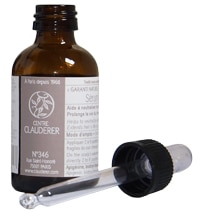- What distinguishes alopecia areata from other hair loss is that it is sudden and totally unpredictable.
- The origin of the disorder has become clearer in recent years, and is most likely an autoimmune disease.
- Heredity may also play a role: 20% of affected patients have a family history of alopecia areata.
- Stress and/or a vitamin D deficiency could be major aggravating factors.
THE SYMPTOMS OF ALOPECIA AREATA
PATCHY ALOPECIA AREATA
Fortunately, this is the most common type of alopecia areata because it is also the most curable. It is defined by sudden hair loss in isolated areas of the scalp, and by the formation of patches completely devoid of hair. The loss is so sudden that the person concerned does not always notice it first: it is often a third party who brings it to their attention. Another feature is the unpredictable nature of this type of hair loss. Often a single plaque appears, sometimes followed by others a few weeks later. Other times, on the contrary, several areas of the scalp become bald at the same time, in a random fashion.
The patches have a rounded shape and develop centrifugally, varying in size from 2 to 8 centimetres in diameter at the end of their development. Another sign is that the hairless areas are often demarcated from the rest of the hair by small broken hairs that are short (1 or 2 cm) and thinning towards the roots. The appearance of these peripheral hairs is reminiscent of an exclamation mark. An expert cannot confuse the patches of alopecia areata with those of trichotillomania, which present non-smooth surfaces, with traces of plucking and small broken hairs.
In more than 50 % cases, hair grows back on its own, between six months and a year after the appearance of the patches, especially in the case of one or two isolated patches. Unfortunately, the quality of regrowth is unpredictable, and it is essential to stimulate it with a suitable treatment as soon as the first symptoms appear (see Clauderer approach, below). When regrowth does occur, it often goes through an intermediate phase: the hair grows back in the form of white down, then thickens and gradually re-pigments.
Recurrences are frequent and unpredictable: in 50-% of cases, they can reappear 5 or 10 years after the first plaques disappeared, without anyone knowing why.
TOTAL ALOPECIA AREATA
Much more rarely (5 % of cases), the process of hair loss can spread to the entire scalp: this is known as 'alopecia totalis'. Even more rarely (0.20 % of cases), alopecia areata spreads to the entire hair system and all the hairs on the body fall out: this is "universal" alopecia areata. The prognosis is more severe for total alopecia areata. On average, hair returns later and more incompletely: only 15 to 25 % grows back spontaneously. Relapses are also more frequent.
COMMON POINTS
Whether partial or total, alopecia affects both men and women. It particularly affects brown hair and young people (around 60 % of cases occur before the age of 20). The average age is around 30.
| Patchy peeling | 95 % of cases |
| Decalcifying peel | 5 % of cases |
| Universal peel | 0.20 % of cases |
| Gender | 50 % men, 50 % women |
| Age first event | 50 % of cases are under 20 years old |
| Average age | 30 years old |
ORIGIN OF ALOPECIA AREATA
Impairment of the hair follicles (small sheaths where the hair roots develop) which suddenly suspend their activity, but are not destroyed. Their cells no longer produce keratin but their work is simply blocked, as if ready to go again. As proof of this, the skin of the scalp remains normal, and the hair holes persist - unlike in androgenetic hair loss, where the inactive follicles sink into the dermis and the skin becomes smooth. The reasons for this deficiency are still the subject of three different hypotheses, which are not mutually exclusive: alopecia areata could be multi-factorial and the combination of those three factors could favour its appearance.
THE AUTOIMMUNE ARGUMENT
A deficiency in the immune system is now considered to be the dominant factor. The argument is based on analysis of the hair follicles affected: they reveal the presence of self-destructive antibodies during the progressive phase of alopecia areata. These same antibodies disappear during the regrowth phase.
Explanation: The immune system normally generates antibodies that enable any organism to protect itself against external aggression. Here, for some unknown reason, the matrix cells produce antibodies which, far from protecting them, attack their own structure and block the formation of keratinocytes.
PSYCHOSOMATIC FACTORS
Statistics show that people with alopecia areata are often anxious or psychologically vulnerable. What's more, they have often undergone a major emotional trauma a few months before the first symptoms appear (loss of a loved one, disruption to the pace of life, intense fear, etc.). Is this trauma the direct cause of hair loss? Or did it simply act as a catalyst in the autoimmune mechanism described above? Opinions differ.
In any case, the stress generated by the disease itself has a negative influence on hair loss. It's a well-known fact that the arbitrary and aesthetically disabling nature of the symptoms frequently triggers a state of anxiety that considerably aggravates the condition itself. Supportive psychotherapy is often recommended to try and break this vicious circle. With the advent of the internet, group therapies have become increasingly popular, offering sufferers the chance to trivialise their disability and support each other.
THE HEREDITARY FACTOR
The genetic route should not be overlooked, since cases of alopecia areata are found in the family histories of 20 % individuals who develop the disease. But the alopecia areata gene has not yet been isolated.
AND VITAMIN D?
Is there a correlation between alopecia areata and vitamin D deficiency? Several studies have already been carried out to clarify this question. The latest two, published in 2014, clearly answer in the affirmative and indicate that all the volunteers with alopecia areata who took part in these two studies had a significant vitamin D deficiency. The second study, published in June 2014 by the British Association of Dermatologists, also shows that the more severe the alopecia areata the greater the vitamin D deficiency.
Sources
– Association between Vitamin D levels and Alopecia Areata
– Vitamin D deficiency in alopecia areata
TREATMENTS FOR ALOPECIA AREATA
There is no miracle cure for alopecia areata. Until its mechanisms are fully understood, no therapy will be able to prevent the onset or recurrence of the disease: alopecia areata develops and relapses at its own pace, and the many treatments currently available can hasten the re-growth process but have no effect on either the onset or definitive cure of the condition.
THE CLAUDERER APPROACH
An in-depth hair diagnosis on site (by appointment, by calling +33(0)1 42 61 28 01) is necessary to examine your scalp, analyse your hair and determine the stage of the disease.

If you are unable to travel, choose the Remote diagnosis. Thank you for enclosing a photo and your telephone number.
Alopecia areata is certainly reversible. However, it is extremely difficult, if not impossible, to predict when hair will grow back in the affected areas.


I'm 18 and I've had alopecia since I was 12 and another since I was 14. Since then I haven't had any regrowth.
Hello, we invite you to read our article on the subject of alopecia :https://www.centre-clauderer.com/chute-cheveux/pelade/. It's very difficult to give you an answer without more information. Some answers are provided in our article, which we hope will be useful to you. Yours sincerely The Clauderer Team